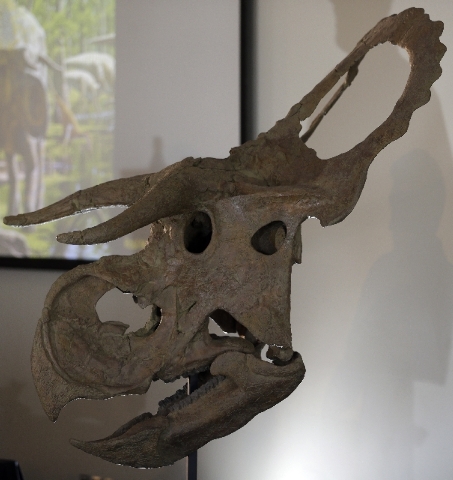Big-nosed, horned-faced dinosaur unearthed in Utah

SALT LAKE CITY — Researchers in Utah said Wednesday they discovered a new type of big-nosed, horned-faced dinosaur that lived about 76 million years ago in the area of what is now the Grand Staircase-Escalante National Monument.
The discovery of the creature, named “Nasutoceratops titusi,” was described in the British scientific journal Proceedings of the Royal Society B and by officials at the National History Museum of Utah in Salt Lake City.
The dinosaur was a wide-bodied plant-eater that grew to 15 feet long and weighed 2 1/2 tons, said Patti Carpenter, spokeswoman for the museum. It is considered unique for its oversized nose and its exceptionally long, curved and forward-pointing horns over the eyes. It also had a low, narrow blade-like horn above the nose.
Research headed by Scott Sampson, former chief curator at the museum, determined that Nasutoceratops lived in a swampy and subtropical environment about 62 miles from the water.
It was part of the same family as the well-known Triceratops, from which it derives part of its name. The second part of the name recognizes paleontologist Alan Titus for his years of research work in the Grand Staircase-Escalante National Monument.
The bones were discovered in 2006 by a University of Utah masters student, Eric Lund. Specimens are permanently housed and displayed at the museum at the University of Utah. Lund, who is now at Ohio University, is a co-author of the study with researchers Mark Loewen, Andrew Farke and Katherine Clayton.
Sampson is now vice president of research and collections at the Denver Museum of Nature & Science. He said researchers don’t believe the large nose of the Nasutoceratops had anything to do with smell, since olfactory receptors were far back in the head.
Horned dinosaurs or “ceratopsids,” were four-footed herbivores that lived during the late Cretaceous period, when the North American continent was split in two by waters of a warm shallow sea.
Researchers call the western portion of the continent Laramidia. It now yields dinosaur digs and research sites from Alaska to Mexico.
Research was funded by the federal Bureau of Land Management, the National Science Foundation and the museums in Salt Lake City and Denver.